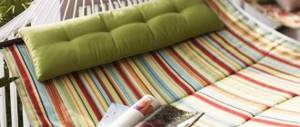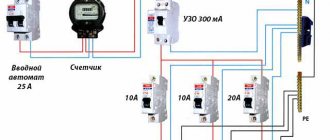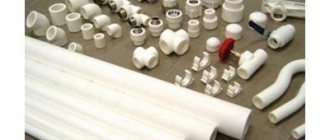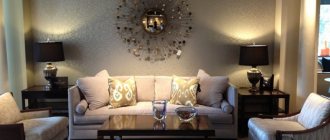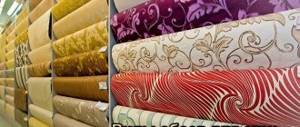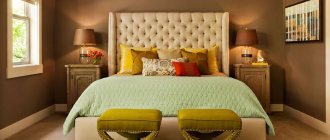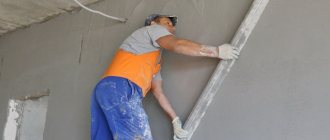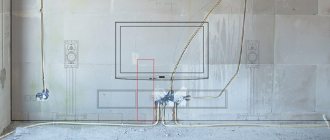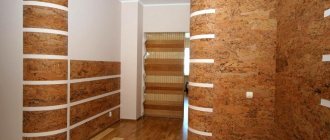To protect against external noise, the walls in the apartment are soundproofed; modern materials for such finishing are varied. You can find ones that are suitable for treating walls and partitions made of concrete, plaster or brick. Most of these materials require final finishing (wallpapering, covering with plasterboard, putty, etc.), so when planning your financial expenses, you need to set aside some for decorative finishing. When the noise from neighbors is insignificant, it is enough to cover the walls with soundproofing wallpaper, which is also commercially available in a wide variety.
When to think about soundproofing
External sounds entering the apartment, for example, neighbors talking loudly, music, roadways next to the house, make you think about soundproofing your home. Not all noise requires such repair; each person can be disturbed by a different irritant. For some, cars passing by will not cause discomfort, but for others, they simply cannot tolerate these sounds.
Noise insulation (sound insulation) - measures to eliminate or partially reduce the level of external noise in a room; it includes the development of a plan, the purchase of materials and repairs.
We cannot change the unpleasant circumstances that prevent us from living, but we can reduce their impact by installing soundproofing structures inside our home.
How to make acoustic insulation of a ceiling: instructions
For this purpose, mainly plasterboard and soundproofing materials are used, which are laid between rigid sheets. These can be the following types of insulation:
- Basalt or mineral wool.
- Coir.
- Cork.
- Polyurethane foam mats.
Before making the main soundproofing of the ceiling, it is necessary to carry out preparatory work. This involves installing a special auxiliary ceiling system:
- Hemmed. They are mounted on a metal frame and then covered with plasterboard.
- Hanging. First, the frame is installed, and then slabs designed for sound insulation are placed on them.
- Tension. They are attached to the ceiling on brackets on which film or fabric for such work is stretched.
The cracks and distances between the plates must be sealed with foam or other materials, which will increase the sound insulation of the ceiling covering several times.
Quite often, mineral wool slabs or panels are used to create acoustic ceilings, which absorb almost 90% of noise from neighbors and muffle sounds coming from the apartment. The installation instructions for mineral wool slabs look like this:
- Install the frame on the ceiling.
- Mineral or basalt wool is placed in it.
- The structure is sheathed with plasterboard boards.
- Puttying is being carried out.
- Wallpaper or paint.
The design is effective, but has a thickness of 15 to 17 cm. Because of this, the ceiling is lowered and the height of the room is reduced.
To soundproof the ceiling, you can use the following methods:
- Install a suspended acoustic ceiling, which is made of a perforated structure.
- Cork slabs or panels.
- Combined systems that use membranes and sound-absorbing boards.
Article on the topic: Soundproofing substrate for wallpaper and acoustic wallpaper
Pros and cons of installing soundproofing
The main advantage of such a repair is the elimination of external noise, and an additional thermal insulation function can also be considered as an advantage.
Question:
What is the main disadvantage of sound insulation in an apartment?
Answer:
The downside is a reduction in living space by several centimeters (from 25 cm, since the width of a standard layer of soundproofing material is 12 cm). Therefore, if you have a home with a small area, you need to think about how important this procedure is.
Schematically, we can consider the principle of operation of noise-insulating material. It can be seen that it cannot absorb all the noise, but it blocks it significantly.
Soundproofing the ceiling in an apartment
And when installing frame structures of cladding and suspended ceilings, it is necessary to separate them from other building structures using Vibrostek M gaskets, followed by sealing the seams with Vibrosil vibroacoustic sealant. A distinct advantage of frame structures is the ability to level the surfaces of walls and ceilings simultaneously with the soundproofing device. A properly executed suspended ceiling with a total thickness of 130 mm increases airborne noise insulation by 19 - 21 dB, provided the initial floor insulation is 49 dB.
At the end of the brief review of measures for additional soundproofing of the apartment, it is necessary to dwell on the issue of an integrated approach to solving this issue. In modern multi-storey buildings, load-bearing structural elements are rigidly and firmly connected to each other into a single whole. This means that noise from a neighbor behind the wall can also be heard from the front wall, behind which is the street, and from the internal partition in your apartment, behind which is a harmless storage room (Fig. 2). And if you isolate only a wall shared with neighbors, the effect of the measures can be only 2 - 3 dB, even when using the most effective materials with indicators of 10 -18 dB.
Because noise spreads simultaneously in all directions and throughout all structures. Passing “bypassing” one isolated surface, it will be emitted by side walls or ceilings. In such cases, all identified “weak links” require additional sound insulation. These are objective laws of physics and must be taken into account when designing acoustic measures in an apartment.
Necessary materials for work
There are three types of materials for soundproofing walls in an apartment:
- Rolls. For the manufacture of such material, fiberglass, polyester fiber, mineral wool and membrane are used. Thanks to this, it turns out to be flexible, lightweight, and able to fit tightly in any corner of the apartment. Therefore, they cover all surfaces.
- Panels. This type is made from cork, basalt, foam plastic, chipboard, mineral wool, quartz sand. Mainly used for walls.
- Plates. The composition and application are the same as in the panels.
Here is the most common sound insulator on a roll. Mineral wool can muffle up to 99% of noise and give a feeling of peace.
How to soundproof walls in an apartment: choosing the material
When choosing, consider the installation method:
- frame;
- floating;
- installation of slabs, membrane materials.
In the first case, flexible coatings are used, but often this technique is used for fastening slabs. Good insulation is done using guides. The frame will hide the free space, so this method is suitable for large rooms. It is permissible to choose a floating method of sound insulation when installing on the floor. In this case, rigid fastening is not used. If you are soundproofing the walls of an apartment from neighbors using slabs, it is enough to use an adhesive to fix the material to the surface.
In each case, different types of coatings are used. They differ in structure. Due to this, during installation, insulation is obtained that is characterized by different properties. However, not all types of materials are universal. Thus, soft covering is not used to protect the floor.
Soft sound insulation
This group includes rolled materials of different thicknesses and structures. The following types are noted:
- mineral wool: characterized by low thermal conductivity, retains sounds well, but can only be used when installing sound insulation of walls using guides, i.e. without a rigid frame, such material will not hold its shape and will quickly lose its properties, in addition, it is necessary to protect the coating from moisture, because upon contact with drops of water, mineral wool is deformed and ceases to perform its function;
- polyester eco-fiber (backing): it is sufficiently rigid, not exposed to high temperatures, holds its shape well, therefore it is often used for laying under laminate; such material is considered when deciding how to make a floating floor;
- needle-punched fiberglass: prevents the spread of noise, and additionally helps reduce heat loss, such a coating is laid on walls, ceilings, and can be used along with a frame structure;
- membrane material: there are varieties made of synthetic and natural fibers; according to the method of fastening, there is a self-adhesive coating and an option for fixing in a standard way (using glue).
Solid insulation includes structures in the form of slabs and panels made of sound-insulating materials
This type of material is suitable for installation on flat surfaces. However, slabs can hide small defects, but not bumps, since the coating is deformed in this case, and the recesses are filled with an adhesive composition. Possible options for do-it-yourself soundproofing of walls in an apartment:
- panels of complex design - combined: they consist of 2 sheets, between which there is a layer, thanks to it you can increase the sound insulation properties of the product; such products are based on particle boards, cork or synthetic material;
- rigid slabs made of polyester fiber: this type belongs to the group of synthetic materials, they are easy to work with, such products are easy to cut, it is better to attach them to the wall using frame technology;
- basalt slabs are a type of fibrous material, but such products are more rigid than wool in rolls (mineral, basalt), it is additionally recommended to treat the coating with waterproofing materials;
- fiberglass slabs: produced using spatula weaving technology, it is recommended to use such products in areas where the surface will not be affected by mechanical load (ceilings, walls, interprofile space);
- cork panels - this type has good soundproofing qualities, it can be used as the main measure against noise, no additional materials are required;
- products made of foam plastic are characterized by a low price, but this is their only advantage, since this type of material is easily deformed and is inferior in efficiency to the considered analogues.
Liquid insulation
Available in the form of a paste, applied in a thin layer to the surface. However, it is recommended to use this type of insulation only to protect multilayer structures. The paste should not be used as an independent measure. The principle of applying such a composition is similar to how sealant is used: using a construction gun, the substance is released under pressure.
Soundproofing from scrap materials
It is acceptable to use other types of coatings that are often used in everyday life, but usually perform other functions. So, among the available materials the leaders are:
- carpet, carpet: today such material is laid only on the floor, and not on the wall, as in former times, however, this option is effective because it blocks up to 30% of noise;
- large-sized wooden furniture, for example, a set that occupies the entire wall, while sounds are not completely eliminated, but only their intensity is reduced;
- curtains, and they should differ in significant length (to the floor), it is also recommended to hang curtains made of the densest material on the cornice, this reduces the intensity of sound waves that propagate from the street.
Types of noise influencing the choice of sound insulation
Depending on the nature and strength of the action, noise can be of two types:
- Wave (air). This type is spread by waves. This includes: music, a running vacuum cleaner, loud conversations from neighbors, a loud TV, sounds from musical instruments, dog barking.
- Vibration (shock). Noise arising as a result of mechanical impacts directly on the walls, transmitted by vibrations through them, other partitions and building structures. The creator of such noise can be: a working hammer drill, other construction tools of a similar type, powerful music speakers, a working washing machine, slamming entrance doors to the entrance.
Before you rush to the hardware store for the material you like, you need to pay attention to the diagram above. After all, the sound insulator you choose may not protect you from annoying noise. Check out the characteristics of this material, which always indicate the level of noise protection with the Rw symbol.
Soundproofing walls in an apartment - step-by-step diagram
Step 1: Sockets
First of all, pay attention to the sockets located on the walls between apartments.
Quite often, for ease of installation, builders make a through hole in the wall to make it easier to install sockets. It is very simple to verify the special role of sockets in breaking silence - at the moments when you hear noise, carefully put your ear to the socket, and you will see that it is precisely the weak link. After turning off the electricity in the apartment for a while, dismantle the product. It is quite possible that you will even stumble into the bottom of your neighbor's outlet. Place a pre-prepared washer made of compacted mineral wool or basalt fiber into the hole. Then apply a layer of gypsum mortar on top of the washer, leaving room for your socket to be installed. If the wall seems very thin to you, you should think about moving the outlet to another place. However, if nothing bothers you, install the product in place.
You should not use polyurethane foam as a sound insulator - it is very dense and does not dissipate and reflect sound well, in addition, some types of it are quite flammable. If we are late with advice, then just plaster the foam properly.
Step 2: Cable Junction Boxes
In new buildings, installation boxes for connecting electrical networks are usually hidden under the ceiling near the center of the inter-apartment walls.
As with sockets, they can be installed in through holes. All that prevents sounds from the next room from penetrating and vice versa are plastic covers. Unfortunately, their sound absorption coefficient is very low. Finding boxes under the wallpaper is very simple - tap the handle of a screwdriver lightly on the wall, a characteristic booming sound will reveal the location of the unit. However, if you are not an electrician by profession, it is better not to go there yourself! This matter should still be handled by a specialist, otherwise you may leave half the house without light. What does not prevent you from preparing materials for sound insulation - the same mineral wool washer, gypsum mortar.
Step 3: Insulate the risers
According to building codes, the risers of water supply and heating pipelines must be closed with vibration-insulated “sleeves” where they pass through interfloor ceilings.
It looks like this: a larger diameter pipe (compared to a riser) is embedded in the ceiling. A gap of several centimeters should form between the walls of this pipe and the riser. It is sealed with soundproofing material and non-hardening acoustic sealant. True, this is all in theory - in practice this is done very rarely! Often, builders simply embed risers into interfloor ceilings. After some time, cracks will certainly form between the pipe and the ceiling, through which noise will be heard. And the risers themselves perfectly transmit impact noise, which in this case is not dampened by anything.
If the builders were simply too lazy to fill the gap between the pipe and the sleeve, correct this omission immediately. If there is no liner at all, clear and remove the layer of coating around the riser, trying to penetrate deeper, but without fanaticism! Then wrap the base of the pipe with asbestos fabric or fiberglass and cement it. After cutting off the excess, seal the joints with sealant.
The older the house, the more flaws you may find! Over time, cracks through which unwanted noise penetrates form at the junction of walls, floors and ceilings. As soon as the opportunity arises to make a complete or partial repair, carefully check all joints and repair all cracks. After completing this set of completely doable tasks, you may be surprised at how much less noise enters your apartment.
Types of sound insulation
Soundproofing of the walls in the apartment is carried out thanks to sound-absorbing and sound-proofing materials. Sound insulation is a kind of barrier that prevents noise from entering from the outside, and sound absorption does not just block noise, but converts it into heat.
Liquid sound insulation (sound insulation)
It is used for walls and ceilings, applied in liquid form to the surface in a 3-centimeter layer. The mixture is poured into all holes and irregularities, providing additional insulating properties. After drying, the walls have a lumpy structure, which is not worth worrying about, because these flaws will later be covered with a sheet of drywall.
Liquid sound insulation, which is also a heat-insulating material, is sold in such containers. This composition is applied between two sheets or on the inside of the decorative finish. When its structure becomes frozen and dense, it is able to reflect sound waves.
Thin insulation (membrane)
A popular finishing option, because the sheet is only 3.7 mm thick, which significantly saves space. Despite its thickness, it is able to provide maximum sound insulation. The environmentally friendly composition of the membrane makes it safe in all respects.
Fiberglass boards
This covering provides excellent sound insulation. Its main disadvantage is considered to be its thickness - 3 cm. In combination with a frame, they take up a lot of living space.
Foamed polyurethane
Such plates are attached with glue.
The picture shows polyurethane foam. For those who are planning to soundproof their front door, this is exactly the material you need. It has high fire resistance and an increased noise blocking coefficient.
Soundproofing an apartment - materials
So, the first task for all apartments is to install soundproofing floors in all rooms. Nowadays, for this purpose, soundproofing floor systems of the “floating” type are mainly used, when the leveling screed under its own weight rests (“floats”) on a layer of soundproofing material and is not rigidly connected to other structures of the building (Fig. 1). The second option is to install floors on joists, supporting them on pads made of vibration-insulating material and filling the internal space with sound-absorbing material. The third option for installing a soundproofing floor is the use of prefabricated floor soundproofing systems ZIPS-POL. This system is a sandwich panel, each of which has 8 elastomer point supports. Perhaps this is the fastest option for installing soundproofing floors in a room. If the room area is 15 sq.m., the ZIPS-FLOOR structure will be ready by the evening, and a day later it can already be covered with a finishing coating.
With a layer of elastic material thickness of up to 20 mm, the design of a soundproofing floor solves only the problem of reducing impact noise. However, if the layer thickness is increased to 20 - 50 mm, this design simultaneously increases the insulation of airborne noise by the ceiling. This can be useful in the case of noisy neighbors downstairs or potentially high sound levels in your premises. In terms of the effectiveness of reducing the level of impact noise, systems of floating floors, floors on joists and ZIPS-FLOOR panels, depending on the thickness of the elastic layer, show values of 23 - 43 dB. In terms of the amount of additional airborne noise insulation, such structures show values of 6 - 12 dB (with a thickness of elastic soybean greater than 20 mm).
To soundproof walls and ceilings, two design options are currently used - frame and frameless cladding and suspended ceiling systems. Both of them cope well with the task, provided that the design parameters are correctly calculated and the installation of sound insulation in the apartment is carried out without violating the technology. If you are not confident in your ability to make the calculation correctly, it would be best to turn to specialists. At the same time, apartment soundproofing services are often offered by people who have little understanding of this topic. Our acoustics engineers will help you choose the optimal solution for soundproofing your apartment in your case.
Returning to frame and frameless systems, it is worth noting that, other things being equal, the fundamental difference between them lies in the installation features. If you plan to carry out soundproofing work on your apartment yourself, simpler and more unpretentious frameless solutions are better suited for you. In addition, their installation is significantly less labor-intensive. Therefore, firstly, you will spend much less time installing sound insulation in your apartment. And, secondly, you will significantly reduce the likelihood of technological errors that often occur at the junctions of the constituent elements of complex structures.
Insulation materials
Soundproofing of walls in an apartment is achieved through the following types of materials.
Isoplat
It is a fiberboard with a soft structure, as it is made from coniferous trees without any adhesive or chemical additives. They can cover walls, ceilings and even floors. The slabs do not have a decorative appearance and therefore require final finishing. It is forbidden to apply a primer to isoplat; it will lose vapor permeability.
Benefits of use:
- a slab thickness of 12 mm is compared with solid wood 44 mm thick;
- high tightness: due to their elasticity, the slabs closely cover the walls, leveling them, closing cracks and holes;
- vapor permeability: does not retain moisture, retaining heat and performing the function of sound insulation;
- easily attached to the sheathing using regular and liquid nails; service life – 70 years.
In the photo Izoplat. Its peculiarity is that it can serve not only as an internal sound insulator, but also as an external windproof board, which is used to cover the facade and roof of the house.
Zips
Two-layer (fiberglass + gypsum fiber) sandwich panel 40 mm thick. The sheet does not have a decorative appearance, and usually plasterboard sheets are built on top of it, together with which the assembled structure reaches 52 cm.
Benefits of use:
- attaches directly to the wall, without the use of lathing;
- maximum sound insulation;
- tongue-and-groove locking system ensuring tight adhesion and no gaps;
- fastening units with vibration noise protection.
Craft
Multilayer soundproofing material consisting of kraft paper, polyethylene, fiberglass, aluminum foil. Produced in rolls 15, 25, 50 m long and 1 meter wide.
Benefits of use:
- environmentally friendly, can even be used in the food industry;
- has an increased level of fire safety;
- prevents moisture penetration.
Soundproofing
Thermal and sound insulation for floors, consisting of bitumen-polymer raw materials.
Benefits of use:
- resistance to rotting;
- elasticity;
- waterproofing;
- long term;
- good acoustic properties.
Soundproofing materials SoundIzol
Ecozvukoizol
Sound insulator consisting of mineral components with a cardboard-like profile, 13 mm thick.
Benefits of use:
- easy;
- ecologically pure;
- does not emit harmful substances during operation.
Panel SoundGuard EcoZvukoIzol
Isotex
Pressed soundproofing panel made of coniferous wood. The panels come in different density and sizes: wall and ceiling. They have a decorative appearance, so they do not require additional finishing.
Benefits of use:
- the porous structure ventilates the room, retaining heat;
- does not rot;
- resistant to temperature changes;
- rich print.
Texound
Soundproofing material made of Aragonite mineral, 1.8 mm thick.
Benefits of use:
- reduces noise level by 2 times;
- flexibility and elasticity easily allows you to place the material in any difficult corners of the room;
- installation in several layers is possible.
Spanish sound insulator Textound is a new material on the sound insulation market. An excellent solution for treating the top of a room with low ceilings, because its thickness does not reduce the height.
Popular materials
- Isoplaat tiles, for the production of which pine wood fibers are used. The thickness of the tile is 10 mm, dampens sounds up to 23 decibels. The tiles are attached to the wall using glue. Recommended for final finishing.
- ZIPS panels, consisting of plasterboard facing sheets and sandwich panels. They are made of dense and soft layers. The thickness of the material depends on the chosen model and can vary from 40 to 130 mm. Sound insulation is 10 decibels. They are attached to the surface using structural units, and for installation to walls it is recommended to use soundproofing gaskets.
- Kraft wall panels are made from wood fibers, included in the boards, wax paper (on the front side), corrugated paper (on the back side). The thickness is 12 mm, dampens sound up to 23 decibels. You can paste over the walls in the apartment, and then attach wallpaper to the panels, as well as for final finishing.
- EcoZvukIzol panel made of 7 layers of cardboard profiles and quartz sand. The thickness is 13 mm, and the sound insulation level is 38 decibels. The panels are attached to the wall with ordinary adhesive for installing drywall.
- Isotex tiles and panels made from softwood fibers. The products have two types of thickness - either 12 mm or 25 mm, but the noise insulation level is 23 decibels. They are mounted using connections called tongue-and-groove.
Article on the topic: Soundproofing the ceiling in an apartment from neighbors above
Comparative characteristics of modern soundproofing materials
Sound insulation of walls, ceilings and floors is carried out using various materials. The current soundproofing market offers so many choices that it can be confusing. We present to your attention a brief summary of popular materials with indicated minimum prices. The table does not contain the entire volume of dimensions, density and other properties, only the main, important characteristics.
| Name | Application area | a brief description of | Price |
| Panel SoundGuard EcoZvukoIzol | Ceiling, walls, floor | 7 layers, panel weight – 18.3 kg/m2, vapor permeability 0.06 mg/m*h*Pa, sound insulation – 24 dB | 11x800x1200 mm – 690 rub/sheet |
| Mineral material “Shumanet-BM” | Ceiling, frame partitions | Density 40 kg/m3, 4 pieces per package weighing 5.5 kg | 50x600x1200 – 260 rub/m2 |
| Softboard (soft board) | Roof, ceiling, walls, floor | Density 180-210 kg/m3, water absorption in 24 hours – 6–8%, vapor permeability 0.2 mg/m*h*Pa | 12x1220x2700 – 463 RUR/sheet |
| Soundproofing panels PhoneStar (Fonstar) | Ceiling, walls, floor | Sound insulation – 36 dB, weight – 0.96 m2, frequency range 20-20t Hz | 12x790x1200 – 1260 rub/m2 |
| Soundproofing KNAUF | Frame and sheathing partitions | 16 pcs per pack, non-flammable, cover area 12.2 m2 | 50x610x1230 – 850 rub/m2 |
| Soundproofing TechnoNIKOL | Frame partitions, ceiling | Vapor permeability 0.3 mg/m*h*Pa, water absorption 1.5%, thermal conductivity at 25 degrees. 0.037 W/m, noise reduction index – 46 dB | 50x600x1200 – 720 rub/pack |
| Soundproofing panel system (ZIPS) | Partitions, walls | Weight 21 kg, noise reduction - 18 dB, density 39 kg/m2 | 120x600x1200 – 1510 rub/piece |
| “Texound” | Ceiling, walls, floor | Noise insulation index – 28 dB, maintaining elasticity up to 20 degrees | 50x1220x3700 – 1400 rub/m2 |
| Soundproofing materials MaxForte | Partitions, walls | Impact noise insulation index – 32 dB, sound absorption index – 0.4 MN, thermal conductivity – 0.036 W/mS, vapor permeability – 0.1 mg/m*h*Pa | 12x1400x6000 – 786 rub/m2 |
| Soundproofing materials ThermoZvukoIzol | Ceiling, walls, floor | Temperature tolerance. from -50 to +140 degrees, insulation index – 28-30 dB, G1. | 14x150x1000 – 3250 rub/roll |
| Soundproofing materials SoundIzol | Ceiling, walls, floor, partitions | Sound insulation index – 28 dB, density 1900 kg/m3, weight 21 kg | 0.4x120x250 – 2530 rub/roll |
| Foam mats: “Pyramid” | Ceiling, walls | Absorption coefficient 0.77, polyurethane foam - 100% | 0.3x100x200 – 1180 rub/sheet |
| Foam mats: “Wave” | Ceiling, walls | Absorption coefficient 0.77, PPU-100% | 0.25x100x200 – 770 rub/sheet |
| Sound insulation materials: glass wool | Walls, roof, floor | Thermal conductivity - 0.036-0.042 W/Mk, G2, T1, D2, vapor permeability - 0.3 mg/m*h*Pa | 50x600x1000 – 548 rub/pack |
| Sound insulation materials: ecowool | Walls, roof, floor | Sound absorption level – 63 dB, pH level – 7.8-8.3 | 15kg (1pack) – 500 rub. |
| Sound curtain with drywall | Ceiling, walls | Noise insulation index – 5 dB, thermal conductivity coefficient – 0.36 W/m·S | 9.5x1200x2000 – 198.58 rub/piece |
| Decorative PVC panels | Walls, ceiling | Withstands temperatures up to +66 degrees, thermal conductivity - 0.159 W/m C | 8x100x3000 – 25 rub/piece |
| Polyurethane boards "Acoustic Gypsum" | Interfloor ceilings | Composition: MDVP, GVL, sound insulation – 11 dB | 50x600x1000 – 124.17 rub/m2 |
| Nowelle vibration damping elastomer plate | Walls, ceiling, floor, foundation | Composition: synthetic rubber | 10x700x700 – 3245 rub/pack |
What is the best material for soundproofing walls to choose for your own comfort?
The materials presented above can prevent sound waves from vibrating or absorb and disperse them. This is the task of absorption that is paramount for soundproofing products, the sound absorption coefficient of which is at least 0.4.
In private houses and apartments, preference is often given to soft versions of sound insulators, since they have the highest sound absorption coefficient and the smallest weight.
The nature of the noise also plays a role. Airborne noise is absorbed by coatings with high porosity and fiber. Structural removes substrates well. Shock volumes are dampened by slabs with a cellular structure.
The better to isolate airborne noise
The sound insulation index is always indicated on the product and is marked with the letters Rw. The value is expressed in decibels. It is advisable to install soundproofing products with a value of at least 50 dB in the apartment.
To dampen airborne noise, it is better to combine sound insulation structures of different degrees of rigidity. For example, a hard background can be concrete, brick, plasterboard, and a soft complement can be a material such as mineral wool, glass wool, or silica fiber.
The effective layer will be a thickness of soft material from 50 mm. In terms of the thickness of the absorbing layer, this is equal to about 50% of the internal area of the partition.
Mineral wool and fiberglass fit all these parameters.
The better to isolate impact noise
The task of isolating impact noise is the repulsion of the sound wave. A porous material will help: the sound wave will have to spend its energy to overcome the elastic components without falling outside the product.
As a solution, cork coverings, polyethylene foam, and substrates are used. Pressed cork sheets do not rot and cope with temperature changes; products made of polyethylene foam in a panel apartment are more often used to soundproof the floor than the walls.
The better to isolate structural noise
Structural noise propagates well throughout any supporting structure, and products made of fiberglass, elastomeric materials, and a substrate based on silica fibers are suitable to eliminate it.
Wallpaper with soundproofing characteristics
Soundproofing the walls in the apartment is carried out not only by thorough repairs, but also with the help of soundproof wallpaper. Three types of wallpaper are currently available:
- Wallpaper "Tufting". The fabric base is covered with a layer of synthetic pile, thus creating a dense fabric that can act as a sound insulator.
- Wallpaper "Velor". A two-layer roll of paper and PVC looks like velvet fabric.
- Cork. Wallpaper consists of a layer of non-woven or paper covered with cork chips.
All soundproofing wallpapers are available with various patterns, ready to satisfy even sophisticated tastes.
The photo shows only a fragment of possible colors and patterns of such wallpaper. They are not only diverse and beautiful on the outside, but also have a high degree of sound absorption.
Reasons for use
Thin insulating material is used to improve the acoustics in a room, making the walls inaccessible to sounds. Other factors for using such material in residential buildings or apartments include:
- The desire to preserve existing square meters, which is important for small spaces.
- Residents want to maintain the ceiling height and room area.
- The need to create a hard surface in order to obtain walls suitable for pasting and painting.
- The desire to protect yourself from annoying neighbors above or to the side, who can move furniture, drill, jump, etc. This causes irritation, so residents want to get rid of the noise coming from their neighbors.
- It is not possible to use complex multilayer structures consisting of soundproofing material and rigid plasterboard layers.
- The need to replace the structure with a modern thin material that protects against the penetration of internal and external sounds.
- The need to make interior spaces silent. Partitions are made inside the apartments that do not absorb noise, but allow you to hear everything that is happening in the next room.
- During the construction of the house, mistakes were made in sealing seams and interior spaces, so there is a need to strengthen protection from noise.
- Over time, buildings, especially high-rise buildings, sag and the sound protection system deteriorates.
Thin sound insulation of the walls in the apartment is carried out with materials such as polyurethane foam, cork, gas-foamed polyethylene, and thermosound insulation. Their special feature is their thickness. It should not exceed 10 mm. Similar sound insulation is produced in the form of rolls, liquid materials, plates, tiles, panels, which have the ability to both insulate from sounds and absorb and reflect them.
